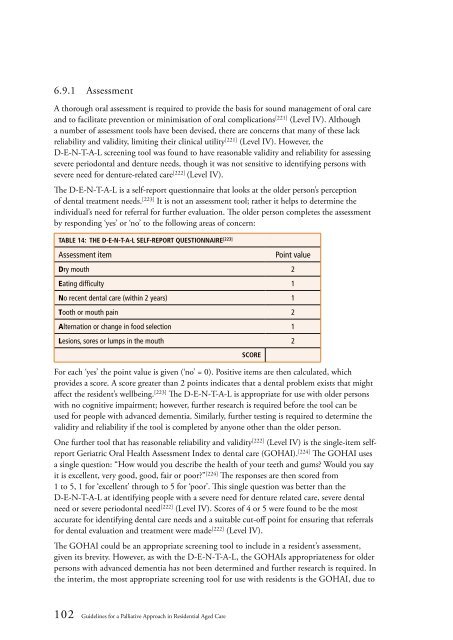Guidelines for a Palliative Approach in Residential Aged Care
Guidelines for a Palliative Approach in Residential Aged Care
Guidelines for a Palliative Approach in Residential Aged Care
You also want an ePaper? Increase the reach of your titles
YUMPU automatically turns print PDFs into web optimized ePapers that Google loves.
6.9.1 Assessment<br />
A thorough oral assessment is required to provide the basis <strong>for</strong> sound management of oral care<br />
and to facilitate prevention or m<strong>in</strong>imisation of oral complications [221] (Level IV). Although<br />
a number of assessment tools have been devised, there are concerns that many of these lack<br />
reliability and validity, limit<strong>in</strong>g their cl<strong>in</strong>ical utility [221] (Level IV). However, the<br />
D-E-N-T-A-L screen<strong>in</strong>g tool was found to have reasonable validity and reliability <strong>for</strong> assess<strong>in</strong>g<br />
severe periodontal and denture needs, though it was not sensitive to identify<strong>in</strong>g persons with<br />
severe need <strong>for</strong> denture-related care [222] (Level IV).<br />
The D-E-N-T-A-L is a self-report questionnaire that looks at the older person’s perception<br />
of dental treatment needs. [223] It is not an assessment tool; rather it helps to determ<strong>in</strong>e the<br />
<strong>in</strong>dividual’s need <strong>for</strong> referral <strong>for</strong> further evaluation. The older person completes the assessment<br />
by respond<strong>in</strong>g ‘yes’ or ‘no’ to the follow<strong>in</strong>g areas of concern:<br />
Table 14: The D-E-N-T-A-L self-report questionnaire [223]<br />
Assessment item<br />
Po<strong>in</strong>t value<br />
Dry mouth 2<br />
Eat<strong>in</strong>g difficulty 1<br />
No recent dental care (with<strong>in</strong> 2 years) 1<br />
Tooth or mouth pa<strong>in</strong> 2<br />
Alternation or change <strong>in</strong> food selection 1<br />
Lesions, sores or lumps <strong>in</strong> the mouth 2<br />
SCORE<br />
For each ‘yes’ the po<strong>in</strong>t value is given (‘no’ = 0). Positive items are then calculated, which<br />
provides a score. A score greater than 2 po<strong>in</strong>ts <strong>in</strong>dicates that a dental problem exists that might<br />
affect the resident’s wellbe<strong>in</strong>g. [223] The D-E-N-T-A-L is appropriate <strong>for</strong> use with older persons<br />
with no cognitive impairment; however, further research is required be<strong>for</strong>e the tool can be<br />
used <strong>for</strong> people with advanced dementia. Similarly, further test<strong>in</strong>g is required to determ<strong>in</strong>e the<br />
validity and reliability if the tool is completed by anyone other than the older person.<br />
One further tool that has reasonable reliability and validity [222] (Level IV) is the s<strong>in</strong>gle-item selfreport<br />
Geriatric Oral Health Assessment Index to dental care (GOHAI). [224] The GOHAI uses<br />
a s<strong>in</strong>gle question: “How would you describe the health of your teeth and gums? Would you say<br />
it is excellent, very good, good, fair or poor?” [224] The responses are then scored from<br />
1 to 5, 1 <strong>for</strong> ‘excellent’ through to 5 <strong>for</strong> ‘poor’. This s<strong>in</strong>gle question was better than the<br />
D-E-N-T-A-L at identify<strong>in</strong>g people with a severe need <strong>for</strong> denture related care, severe dental<br />
need or severe periodontal need [222] (Level IV). Scores of 4 or 5 were found to be the most<br />
accurate <strong>for</strong> identify<strong>in</strong>g dental care needs and a suitable cut-off po<strong>in</strong>t <strong>for</strong> ensur<strong>in</strong>g that referrals<br />
<strong>for</strong> dental evaluation and treatment were made [222] (Level IV).<br />
The GOHAI could be an appropriate screen<strong>in</strong>g tool to <strong>in</strong>clude <strong>in</strong> a resident’s assessment,<br />
given its brevity. However, as with the D-E-N-T-A-L, the GOHAIs appropriateness <strong>for</strong> older<br />
persons with advanced dementia has not been determ<strong>in</strong>ed and further research is required. In<br />
the <strong>in</strong>terim, the most appropriate screen<strong>in</strong>g tool <strong>for</strong> use with residents is the GOHAI, due to<br />
102 <strong>Guidel<strong>in</strong>es</strong> <strong>for</strong> a <strong>Palliative</strong> <strong>Approach</strong> <strong>in</strong> <strong>Residential</strong> <strong>Aged</strong> <strong>Care</strong>
















